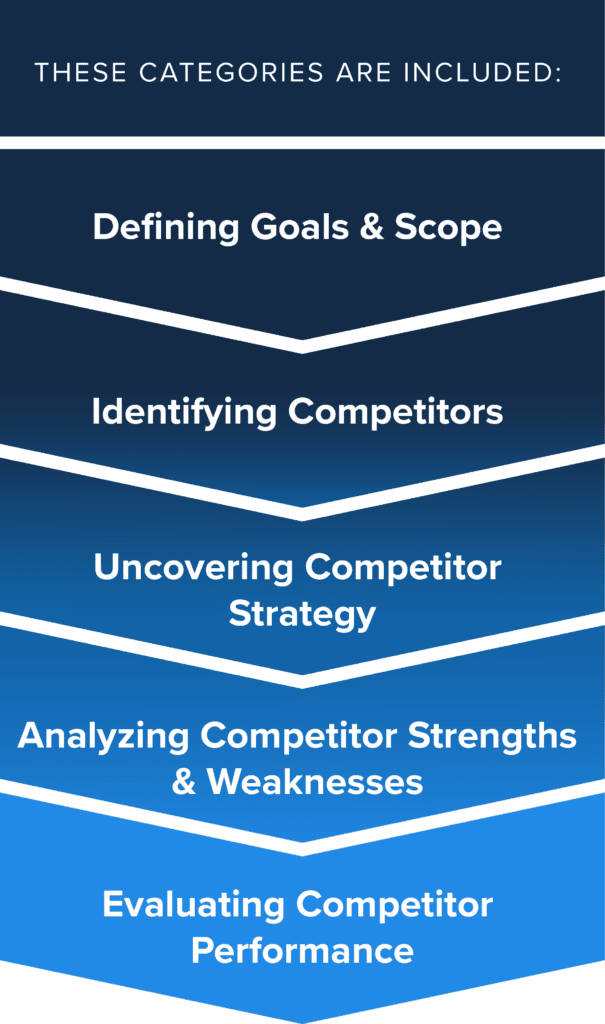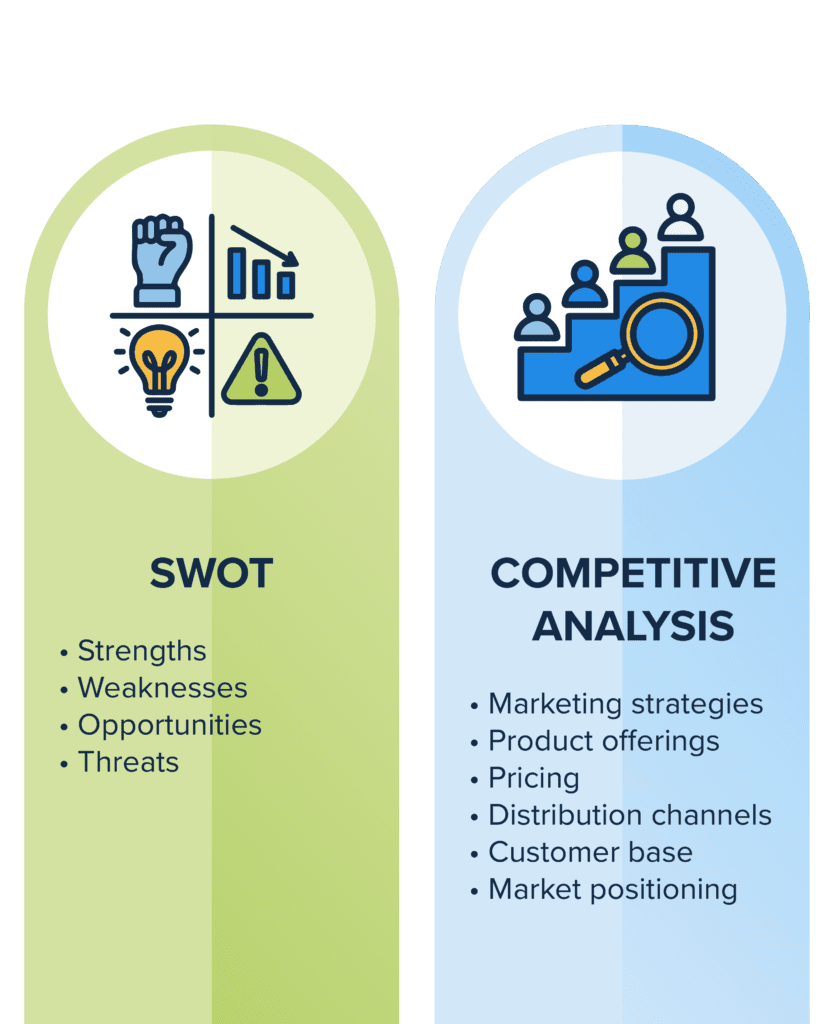
Understanding your competition is not just an option but a necessity for the success of your marketing efforts. A comprehensive competitor analysis allows you to gain valuable insights into your competitors:
- Strategies
- Strengths
- Weaknesses
- Performance
Armed with this knowledge, you can refine your own marketing campaigns, capitalize on opportunities, and stay ahead in the market.
In this article, we will provide a detailed, step-by-step guide on how to perform a thorough and effective competitive analysis in digital marketing.
Understanding the Competitive Analysis in Marketing
It’s vital to have a clear understanding of what a competitive analysis entails and why it is crucial for your digital marketing strategy. A competitive analysis is a systematic evaluation of your competitors’ marketing strategies, positioning, and performance to identify opportunities and areas for improvement. It involves gathering data, analyzing key metrics, and extracting actionable insights that can inform and enhance your own marketing efforts.
To conduct a successful competitive analysis, you need to go beyond surface-level observations and understand the deeper dynamics of your market. This requires a comprehensive understanding of your industry, target market, and the key players within it. After gaining insights into your competitors’ strategies, you can:
- Identify gaps in the market
- Differentiate your offerings
- Develop marketing initiatives that resonate with your audience
Step-by-Step Guide: How to Perform a Competitive Analysis
A proper competitive analysis should follow these steps:

Define Your Goals and Scope
To start your thorough competitor analysis, define clear goals and establish the scope of your analysis. Identify the specific aspects of your competitors’ digital marketing efforts that you want to assess, such as their
- Online presence
- Content marketing
- Social media presence
- Advertising campaigns
Align these goals with your overall marketing objectives and ensure that your analysis is focused and targeted.
Additionally, consider the scope of your analysis. Are you focusing on local competitors or international ones? Will you be analyzing specific marketing channels or taking a holistic approach? Defining the scope helps you allocate your resources effectively and ensures that your analysis is tailored to your specific needs.
Identify Competitors
Identifying your competitors is the first step in conducting a competitive analysis. Start by compiling a list of both direct and indirect competitors.
- Direct competitors operate within the same industry and target a similar audience, offering products or services that are comparable to yours
- Indirect competitors, on the other hand, may offer alternative solutions or products that cater to the same target market
Competitor research should be conducted utilizing a combination of methods. Conduct keyword research to identify websites and businesses that rank for similar keywords as yours. Explore social media platforms to find competitors that are actively engaging with your target audience. Utilize industry directories and market research reports to uncover competitors that may not be immediately apparent.
Research Competitor Strategies
Once you have identified your competitors, it’s time to gather in-depth information about their marketing strategies.
- Start by analyzing their online presence, including their websites, social media profiles, and content marketing efforts
- Look for patterns in their messaging, tone, and visual branding
- Assess their content strategies, such as the types of content they produce, the platforms they use, and the frequency of their updates
- Examine their paid ads and promotional activities, and identify the channels they utilize, the messages they convey, and the target customers they are addressing
- Study their search engine optimization (SEO) strategies, such as the keywords they target and the backlinks they have acquired
After this brief competitor analysis, you can gain insights into what is working for your competitors and adapt or refine your own approaches accordingly.
Analyze Competitor Strengths and Weaknesses
Analyzing your competitors’ strengths and weaknesses is crucial to identify areas where you can differentiate yourself and gain a competitive edge. Assess their
- Brand reputation
- Customer loyalty
- Product offerings
- Customer experience
Look for unique selling propositions that set them apart and determine why customers choose them over others. A complete online competitor analysis is always faceted and thorough.
At the same time, identify their weaknesses and vulnerabilities. Are there gaps in their product offerings that you can fill? Are there areas where their customer service falls short? Analyze customer reviews, ratings, and feedback to gain insights into where they may be underperforming.
Evaluate Competitor Performance
It’s essential to evaluate your competitors’ performance. Utilize data and analytics to measure and compare key performance indicators (KPIs) such as website traffic, social media engagement, conversion rates, and customer satisfaction. Identify the areas where your competitors are excelling and the areas where they may be falling behind.
Evaluate their online visibility/organic search rankings and assess their social media following and engagement metrics. Look for indications of their success, such as the number of customer reviews, testimonials, or case studies they have. This competitive market analysis will allow you to gain insights into the strategies that work and adapt them to your own marketing initiatives.
What Makes a Good Competitive Analysis?
A good competitive analysis is characterized by its objectivity, thoroughness, and actionable insights. To ensure objectivity, approach the analysis with an open mind and avoid biases. Gather data from reliable sources and verify the information before drawing conclusions.
Thoroughness is key in a competitive analysis. Leave no stone unturned and gather as much information as possible about your competitors. Utilize various research methods, tools, and techniques to gain a comprehensive understanding of their strategies and performance.
Finally, the analysis should provide actionable insights that can drive your marketing decisions. Identify patterns, trends, and opportunities that can be leveraged to refine your own marketing strategies. Develop specific action plans based on the insights gained from the analysis to outperform your competition.
Is a SWOT Analysis a Competitive Analysis?
A SWOT analysis is a valuable tool for assessing your internal capabilities and external market conditions. It helps you identify your strengths and weaknesses as well as the opportunities and threats that exist in your industry. However, a SWOT analysis alone is not sufficient for a comprehensive competitive analysis.
While a SWOT analysis provides a broad overview of your business’s internal and external factors, a competitive analysis delves deeper into the strategies and positioning of specific competitors. It focuses on understanding the landscape in which your business operates and gaining insights into your competitors’ activities.
A competitive analysis involves researching and analyzing your competitors’
- Marketing strategies
- Product offerings
- Pricing
- Distribution channels
- Customer base
- Positioning
It aims to identify their strengths and weaknesses relative to your own business. You’ll uncover valuable insights that can inform your own marketing decisions and help you differentiate yourself in the market.
By combining a SWOT analysis with a competitive analysis, you can gain a more comprehensive understanding of your business’s competitive position. The SWOT analysis provides a foundation by highlighting your internal strengths and weaknesses, as well as external opportunities and threats. The competitive analysis then builds upon this foundation by examining how your competitors’ strategies align with or differ from yours, allowing you to identify areas where you can gain a competitive advantage.

For example, while a SWOT analysis might reveal that your business has a strong online presence and a loyal customer base, a competitive analysis might reveal that one of your competitors excels in content marketing and has a unique value proposition that appeals to a specific niche market. This information can help you identify opportunities to enhance your content marketing efforts and refine your value proposition to better compete in that niche.
While a SWOT analysis provides a valuable assessment of your business’s internal and external factors, a competitive analysis takes it a step further by evaluating your competitors’ strategies and performance. Combining both approaches gives you a more holistic view of your market and helps you make informed decisions to stay ahead of the competition.
The Relationship Between Competitive Analysis and Benchmarking
Competitive analysis and benchmarking are two valuable tools that, when used together, provide a comprehensive understanding of the market and help you assess your position within it. Where competitive analysis focuses on evaluating your competitors, benchmarking allows you to measure and compare your own performance against industry standards or best practices.
Let’s explore the relationship between these two approaches in more detail.
The Role of Competitive Analysis
Competitive analysis involves researching and analyzing your competitors’ strategies, strengths, weaknesses, and performance. It helps you gain insights into their marketing approaches, customer engagement, product offerings, pricing, and positioning.
Through competitive analysis, you can uncover market opportunities that your competitors may have overlooked or areas where they are underperforming. These insights help you identify gaps in the market that you can capitalize on and provide solutions or offerings that differentiate you from the competition.
The Role of Benchmarking
Benchmarking involves measuring and comparing your own performance against industry standards, competitors, or best practices. Here’s all you need to know:
Measuring Performance
Benchmarking helps you understand how well you are performing in key areas such as website traffic, conversion rates, customer satisfaction, social media engagement, or other relevant metrics. By benchmarking your performance, you gain insights into areas where you excel and areas that require improvement.
Identifying Performance Gaps
By comparing your Key Performance Indicators (KPIs) with those of others in your industry, you can identify areas where you are lagging behind or have the potential to outperform. This helps you set realistic goals for improvement and identify specific strategies to bridge the performance gaps.
Learning Best Practices
Benchmarking provides an opportunity to learn from industry leaders and identify best practices. By studying the top performers in your industry, you can gain insights into the strategies, tactics, and approaches that have led to their success. This knowledge can inspire innovative thinking, spark new ideas, and guide the development of effective marketing strategies.
The Synergy Between Competitive Analysis and Benchmarking
When combined, competitive analysis and benchmarking offer a holistic view of your market and your own performance within it. By evaluating your competitors and benchmarking your performance, you can:
- Set Realistic Goals: Competitive analysis helps you understand the performance levels of your competitors, allowing you to set realistic goals for your own business. By benchmarking against industry leaders, you can identify achievable performance targets that align with the best practices in your field.
- Identify Areas for Improvement: Both competitive analysis and benchmarking reveal areas where your business may be falling behind or underperforming. By understanding these gaps, you can develop strategies to improve your performance and close the distance between you and your competitors.
- Gain a Competitive Edge: Through competitive analysis, you gain insights into your competitors’ strategies, strengths, and weaknesses. By benchmarking your performance, you can identify opportunities to outperform your competitors and gain a competitive edge. This combination enables you to develop effective marketing strategies that leverage your strengths and capitalize on your competitors’ weaknesses.
Competitive Analysis for Digital Marketing With Elevato
Conducting a competitive analysis is a fundamental step in developing a successful digital marketing strategy. Following a comprehensive and structured approach will offer insights into your competitors’ strategies, strengths, weaknesses, and performance. This knowledge empowers you to refine your own marketing approaches, capitalize on opportunities, and stay ahead of the competition.
Remember, a competitive analysis is an ongoing process that requires continuous monitoring and adaptation to keep pace with the dynamic digital landscape. Embrace the power of competitive analysis, leverage it to inform your marketing decisions, and position yourself for success in the digital marketing arena. Elevato is a top digital marketing agency and our team can help send you to the very top of the leaderboard, surpassing all your competition. Get started today.
